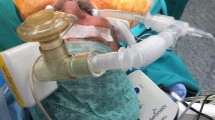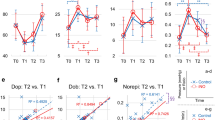Summary
Background: Inhaled nitric oxide (NO) has been shown to selectively lower pulmonary vascular resistance and is applied in patients with pulmonary hypertension (PHT). However, application and monitoring is complex and not always successful („non‐responders”). We evaluated the effect of aerolized prostacyclin (aePGI2) as a therapeutic alternate to NO.
Patients and methods: aePGI2 and NO were applied to patients with different causes of pulmonary hypertension (Group 1a: preoperative patients with intracardiac shunting defects and Eisenmenger's disease, n = 30; Group 1b: patients with primary or postoperative PHT, n = 13; Group 2: PHT immediately following surgery for congenital heart disease, n = 6).
Results: Pulmonary vascular resistance could be lowered significantly (Group 1a: from 91 % of systemic vascular resistance to 58 % with NO and 53 % with aePGI2; Group 1b: from 20.2 Wood Units * m2 to 13.4 and 11.3; Group 2: from 24.9 Wood Units * m2 to 9.5 and 10.5); cardiac index increased (Group 1b: 2.96 to 3.55 and 3.96l/min * m2, Group 2: from 1,57 to 1,89 and 2.00l/min * m2).
Conclusions: The short‐term application of aePGI2shows a selective pulmonary vasodilation similar to NO. Given adequate monitoring, aePGI2 appears to be useful for the acute treatment of PHT.
Zusammenfassung
Hintergrund: Inhalatives Stickmonoxyd (NO) wirkt selektiv auf den pulmonalen Gefäßwiderstand und wird bei der Therapie von Patienten mit pulmonaler Hypertension (PHT) eingesetzt, jedoch mit hohem apparativem Aufwand und nicht immer erfolgreich („non‐responder”). Wir evaluierten die Wirksamkeit von aerosolisiertem Prostazyklin (aePGI2) als therapeutische Alternative zu NO.
Patienten und Methodik:Bei einer Herzkatheteruntersuchung wurde mittels NO und aePGI2 die pulmonale Vasoreagibilität von Patienten mit intrakardialen Shuntvitien und Eisenmengen‐Reaktion (Gruppe 1a, n = 30) und Patienten mit primärer und postoperativer PHT (Gruppe 1b, n = 13) untersucht; unmittelbar postoperativ wurde auf der Intensivstation aePGI2 im Vergleich zu NO bei postoperativer PHT eingesetzt (Gruppe 2, n = 6).
Ergebnisse:Der Lungengefäßwiderstand konnte signifikant gesenkt werden (Gruppe 1a: von 91 % des Systemwiderstandes auf 58 % mit NO bzw. 53 % mit aePGI2; Gruppe 1b: von 20,2 Wood Units * m2 auf 13,4 bzw. 11,3; Gruppe 2: von 24,9 Wood Units * m2 auf 13,4 bzw. 11,3; Gruppe 2: von 24,9 Wood Units * m2 auf 10,5 bzw. 9,5), der Herzminutenvolumen‐Index erhöhte sich (Gruppe 1b: von 2,96 auf 3,55 und 3,96 l/min * m2, Gruppe 2: von 1,57 auf 1,89 und 2,00 l/min * m2).
Schlußfolgerung: Der kurzfristige Einsatz von aePGI2zeigt eine mit NO vergleichbare selektive pulmonale Vasodilatation und erscheint bei entsprechendem umfassendem Monitoring zur akuten Behandlung von pulmonalhypertensiven Zuständen vertretbar.
Similar content being viewed by others
Author information
Authors and Affiliations
Additional information
Eingegangen: 28. Juni 1996¶Akzeptiert: 20. August 1996
Rights and permissions
About this article
Cite this article
Schulze‐Neick, I., Uhlemann, F., Nürnberg, J. et al. Aerosolisiertes Prostazyklin zur präoperativen Evaluation und postkardiochirurgischen Behandlung von Patienten mit pulmonaler Hypertension. Z Kardiol 86, 71–80 (1997). https://doi.org/10.1007/s003920050036
Issue Date:
DOI: https://doi.org/10.1007/s003920050036




